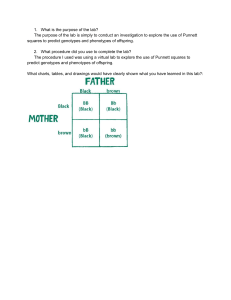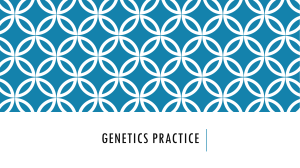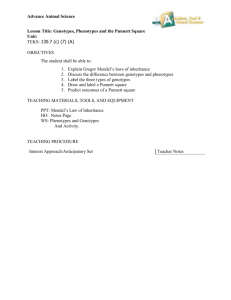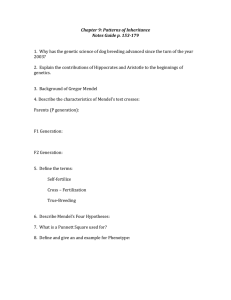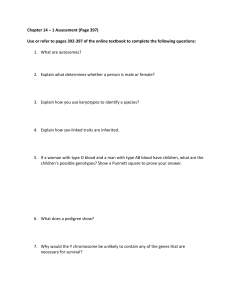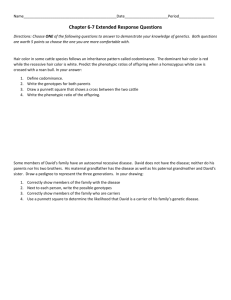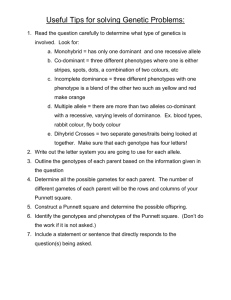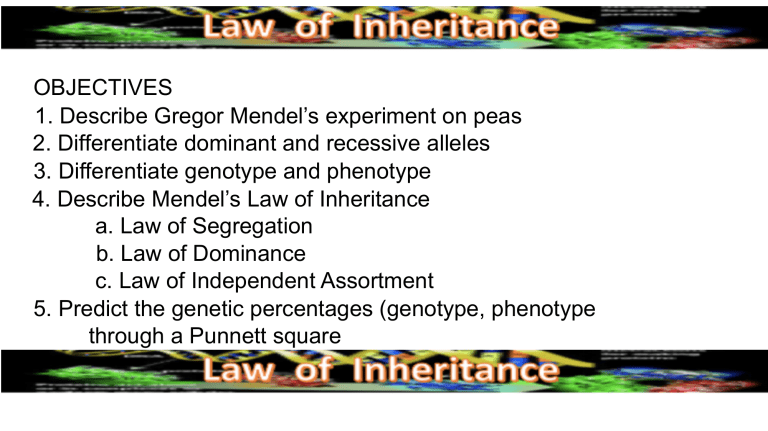
OBJECTIVES 1. Describe Gregor Mendel’s experiment on peas 2. Differentiate dominant and recessive alleles 3. Differentiate genotype and phenotype 4. Describe Mendel’s Law of Inheritance a. Law of Segregation b. Law of Dominance c. Law of Independent Assortment 5. Predict the genetic percentages (genotype, phenotype through a Punnett square VOCABULARIES 1. Genetics 2. gene 3. allele 4. homozygous ex. AA, aa, BB, cc, 5. heterozygous ex. Aa, Bb, Cc 6. genotype ex. AA, aa, Bb, AABB 7. phenotype ex. Skin color, height 8. dominant gene ex. AA, BB 9. recessive gene ex. aa, bb, cc 10. Punnett square 11. F1, F2 Differentiate homozygous allele and heterozygous allele Differentiate genotype and phenotype Johann Gregor Mendel (1822-1884) Father of Genetics Gregor Mendel, through his work on pea plants, discovered the fundamental laws of inheritance. He deduced that genes come in pairs and are inherited as distinct units, one from each parent. He tracked the segregation of parental genes and their appearance in the offspring as dominant or recessive traits, recognized the mathematical patterns of inheritance from one generation to the next. Mendel's Laws of Heredity are usually stated as: 1) The Law of Segregation: Each inherited trait is defined by a gene pair. Parental genes are randomly separated to the sex cells so that sex cells contain only one gene of the pair. Offspring inherit one genetic allele from each parent when sex cells unite in fertilization. 2) The Law of Independent Assortment: Genes for different traits are sorted separately from one another so that the inheritance of one trait is not dependent on the inheritance of another. 3) The Law of Dominance: An organism with alternate forms of a gene will express the form that is dominant. The genetic experiments Mendel did with pea plants took him eight years (1856-1863) and he published his results in 1865. During this time, Mendel grew over 10,000 pea plants, keeping track of progeny number and type. Mendel's work and his Laws of Inheritance were not appreciated in his time. It wasn't until 1900, after the rediscovery of his Laws, that his experimental results were understood. Give your insight about Gregor Mendel’ experiment Mendel's First Law, also called The Law of Equal Segregation, which states: during gamete formation, the two alleles at a gene locus segregate from each other; each gamete has an equal probability of containing either allele.Apr 9, 2022 A Punnett square can be used to predict genotypes (allele combinations) and phenotypes (observable traits) of offspring from genetic crosses. A test cross can be used to determine whether an organism with a dominant phenotype is homozygous or heterozygous. Mendel's law of segregation | Genetics (article) | Khan Academy https://www.khanacademy.org › ... › Mendelian genetics PUNNETT Square Practice Monohybrid cross Create a Punnett square then identify the genotypes, genotypic, phenotypes and phenotypic ratio 1. male parent AA X female parent AA (A- brown eyes) GENOTYPES: Genotypic ratio: PHENOTYPES: Phenotypic ratio: PUNNETT Square Practice Monohybrid cross Create a Punnett square then identify the genotypes, genotypic ratio, phenotypes and phenotypic ratio 2. male parent Aa X female parent Aa (A – curly hair, a – straight hair) GENOTYPES: Genotypic ratio: PHENOTYPES: Phenotypic ratio: PUNNETT Square Practice dihybrid cross Create a Punnett square then identify the genotypes, genotypic ration, phenotypes and phenotypic ratio 3. Male parent AABB. X female parent aabb ( A- brown complexion, a- fair complexion) (B – tall, b – short) GENOTYPES: Genotypic ratio: PHENOTYPES: Phenotypic ratio: PUNNETT Square Practice dihybrid cross Create a Punnett square then identify the genotypes, genotypic ration, phenotypes and phenotypic ratio 4. Male parent AaBb. X female parent AaBb ( A- black, a- albino). (B – big, b – small) GENOTYPES: Genotypic ratio: PHENOTYPES: Phenotypic ratio: What does law of dominance in the genetics mean? How does the law of dominance shown in the picture? The Principle of Independent Assortment describes how different genes independently separate from one another when reproductive cells develop. Independent assortment of genes and their corresponding traits was first observed by Gregor Mendel in 1865 during his studies of genetics in pea plants. Principle of independent assortment - Nature What does Law of Independent Assortment mean? How do phenotypes and genotypes show the Law of Independent Assortment? What is the genotypic ratio? What is the phenotypic ratio? CHROMOSOME - a threadlike structure of nucleic acids and protein found in the nucleus of most living cells, carrying genetic information in the form of genes. Autosome –not a sex chromosome Sex chromosome-chromosomes that determine the gender of organism HUMAN has 46 or 23 pairs of chromosomes Autosomes = 44 or 22 pairs Sex chromosome = 2 0r 1 pair = XY gene from the other parent is normal. The abnormal gene dominates. Most of sex link traits/ diseases are carried by X chromosome Jan 28, 2020 Sex-linked traits/diseases are passed down through families through one of the X or Y (sex) chromosomes. Sex-linked recessive: MedlinePlus Medical Encyclopedia Dominant inheritance occurs when an abnormal gene from one parent causes Three types of Sex Linked Inheritance trait/disease, even though the matching ⮚X - linked dominant ⮚X - linked recessive ⮚Y - linked Examples of X-linked dominant disorders 1. Rett syndrome (female- mental retardation, microcephaly, autism) 2. X-linked Lissencephaly “smooth brain”(male-abnormal development of brain and genitalia) 3. double-cortex syndrome (female- epilepsy, mental dis abilty) 4. incontinentia pigmenti type 1, characterized by dermatological, ocular, dental, and neurological abnormalities. X-Linked Dominant Disorders - an overview - ScienceDirect.com https://www.sciencedirect.com › topics › neuroscience › x... X-linked recessive inheritance refers to genetic conditions associated with mutations in genes on the X chromosome. A male carrying such a mutation will be affected, because he carries only one X chromosome. A female carrying a mutation in one gene, with a normal gene on the other X chromosome, is generally unaffected. Definition of X-linked recessive inheritance - NCI Dictionary of ... https://www.cancer.gov › genetics-dictionary › def › x-lin... X-Linked Recessive Disorders •Red-green color blindness (male) •Hemophilia A. •Duchenne Muscular dystrophy/DMD (male- muscle pain, stiffness, learning disability Y- Linked inheritance Hypertrichosis of the ears, webbed toes, and porcupine man(excessive dry skin) are examples of Y-linked inheritance in humans. Hypertrichosis of the ears (or hairy ears) is a condition wherein there is a conspicuous growth of hair on the outside rim of the ear.Jun 28, 2021 Y-linked inheritance - Definition and Examples Biology Online http FAMILY PEDIGREE A diagram of family history that uses standardized symbols. A pedigree shows relationships between family members and indicates which individuals have certain genetic pathogenic variants, traits, and diseases within a family as well as vital status and health condition through generations of a family. Pedigrees are normally used to represent simple dominant and recessive traits. For example, having a widow's peak hairline is dominant. If an individual has that trait, their symbol on the pedigree will be shaded in. Break out room activity: ⮚ watch the video https://www.youtube.com/watch?v=uhK qmNOiPR8 ⮚ Create a family pedigree using a hypothetical trait legend for the pedigree chart Individual activity (Gdocs) ⮚ Create a family pedigree for 3 generations ( your grand parents, your parents and you and siblings) ⮚ Explain the family pedigree your created, consider dominance or recessive, affected or carrier
